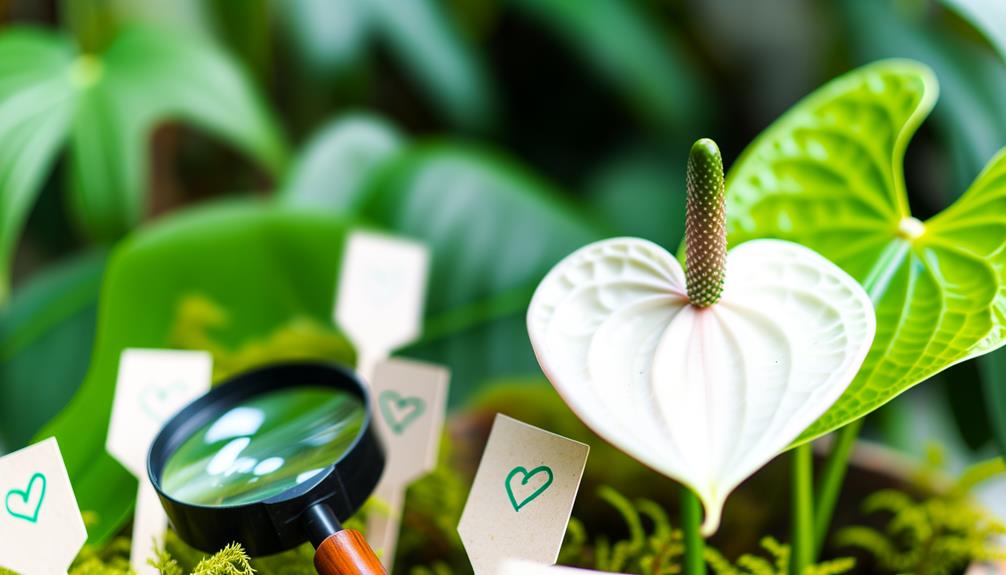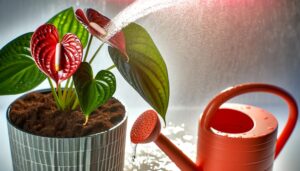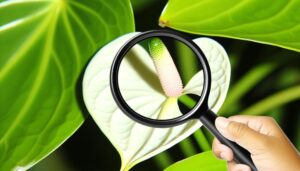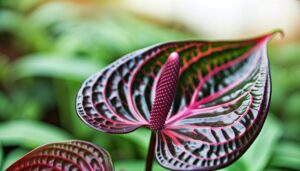How to Identify the Scientific Name of White Anthurium
To identify the scientific name of White Anthurium, examine for key features. Look for a glossy, heart-shaped spathe enveloping a straight spadix and dark green, leathery, cordate leaves.
The scientific name you're looking for is Anthurium andraeanum. Compare with similar species like Anthurium scherzerianum, which has a spiraled spadix, to guarantee accuracy.
Consult trusted botanical databases like The Plant List or Tropicos, and use textbooks for additional verification. Accurate documentation of spathe shape, color, and leaf morphology can provide further confirmation.
Understanding these specifics will enhance your identification acumen.

Key Takeaways
- Examine the white spathe's glossy, waxy texture and heart-shaped form.
- Observe the straight spadix centrally positioned within the white spathe.
- Check for dark green, leathery, heart-shaped leaves with a glossy surface.
- Note the long-lasting inflorescence characteristic of Anthurium andraeanum.
- Compare with trusted botanical references to confirm Anthurium andraeanum.
Understanding Botanical Nomenclature
Botanical nomenclature, the formal system of naming plant species, relies on a binomial format, consisting of the genus name followed by the specific epithet.
You'll start with the genus, a broader classification grouping plants with shared traits. For instance, in *Anthurium andraeanum*, *Anthurium* represents the genus. The specific epithet, *andraeanum*, narrows it down to a unique species within the genus.
This system, devised by Carl Linnaeus, guarantees each plant has a universally recognized name, avoiding confusion. When you encounter a plant, identifying its genus and specific epithet helps you understand its characteristics and lineage.
Anatomy of White Anthurium
In examining the anatomy of the white anthurium, *Anthurium andraeanum*, focus on its distinct spathe and spadix structure. The spathe, a modified bract, showcases a pristine white hue, enveloping the spadix. The spadix, an inflorescence axis, holds numerous minute flowers. You'll notice the leaves are cordate, with a glossy, leathery texture. The petioles are long and slender, providing a graceful stance.
Here's a concise breakdown of key anatomical parts:
| Part | Description |
|---|---|
| Spathe | White, modified bract |
| Spadix | Central inflorescence axis |
| Leaves | Cordate, glossy, leathery |
| Petioles | Long, slender |
| Roots | Adventitious, fibrous |
Key Identifying Features
One of the key identifying features of *Anthurium andraeanum* is its striking white spathe, which envelops the spadix and provides a visually enchanting contrast.
The spathe, a modified bract, exhibits a glossy, waxy texture that enhances its allure. The spadix, typically yellow or cream, stands erect at the center, surrounded by the elegant spathe.
You'll notice the heart-shaped leaves, which are dark green and leathery, adding to the plant's distinctive appearance. The leaves have prominent veins, contributing to a lush, tropical aesthetic.
Additionally, the inflorescence of *Anthurium andraeanum* is long-lasting, often persisting for several weeks. By observing these features closely, you can confidently identify the white anthurium as *Anthurium andraeanum*.
Reviewing Common Species
You'll find that several species within the *Anthurium* genus, such as *Anthurium scherzerianum* and *Anthurium crystallinum*, each possess unique characteristics that make them distinguishable from *Anthurium andraeanum*.
*Anthurium scherzerianum* is noted for its spiraled spadix and elongated, lanceolate leaves.
In contrast, *Anthurium crystallinum* boasts large, velvety leaves with prominent white venation, giving it a crystalline appearance.
Meanwhile, *Anthurium andraeanum* features broad, heart-shaped leaves and a straight spadix. The inflorescence of *A. andraeanum* typically exhibits a glossy, colorful spathe, often red or pink.
Recognizing these distinctive traits allows you to differentiate between species accurately. When you observe these plants, focus on leaf shape, spadix form, and spathe color to identify them correctly.
Consulting Botanical References
To accurately identify the scientific name of the white Anthurium, consult trusted plant databases like The Plant List and Tropicos. These databases provide detailed taxonomic information and nomenclatural updates.
Additionally, reference botanical textbooks such as 'Tropical Flowering Plants: A Guide to Identification and Cultivation' for thorough descriptions and illustrations.
Trusted Plant Databases
Consulting trusted plant databases like The Plant List or the International Plant Names Index (IPNI) is essential for accurately identifying the scientific name of white anthurium, ensuring you reference *Anthurium andraeanum* correctly. These databases are invaluable for verifying current nomenclature and taxonomic details.
When you access these resources, you'll find:
- Taxonomic Hierarchy: Detailed classification from Kingdom to Species.
- Synonymy: Historical and alternative names for *Anthurium andraeanum*.
- Publication References: Original descriptions and botanical literature.
These features help you avoid outdated or incorrect names, ensuring precision in your botanical references. By relying on these authoritative sources, you maintain scientific accuracy in identifying and documenting your white anthurium.
Botanical Textbooks Resources
Frequently, botanical textbooks like 'The Anatomy of Flowering Plants' provide detailed descriptions and illustrations that are invaluable for accurately identifying *Anthurium andraeanum*. You'll find in-depth sections on leaf morphology, venation patterns, and inflorescence structure.
Pay close attention to the spadix, spathe, and the arrangement of the leaves, as these are critical for distinguishing *Anthurium andraeanum* from other species.
Also, consult the section on habitat specificity; understanding its native environment helps confirm your identification. Don't overlook the glossary for definitions of technical terms you might encounter.
Using Online Plant Databases
You'll find that utilizing online plant databases can greatly simplify identifying the scientific name of white Anthurium, such as Anthurium andraeanum.
Focus on database search techniques, using keywords like 'Anthurium' and 'white spathe,' to filter results accurately.
Verify you're consulting reliable plant resources like The Plant List or Tropicos for the most precise information.
Database Search Techniques
Many online plant databases, such as The Plant List and Tropicos, provide detailed taxonomic information that can help you accurately identify the scientific name of white Anthurium (Anthurium andraeanum).
To effectively use these resources, you should:
- Search by Latin name: Inputting 'Anthurium andraeanum' directly into the search bar yields the most precise results.
- Use filters: Narrow down your search by selecting criteria like geographic distribution or plant habit.
- Examine synonyms: Databases often list synonyms, ensuring you account for historical naming variations.
Reliable Plant Resources
When seeking reliable plant resources, databases like The Plant List and Tropicos offer extensive taxonomic data, including the scientific name Anthurium andraeanum. You'll find these platforms invaluable for their detailed records on species classification, synonyms, and distribution.
The Plant List provides a thorough, curated database of plant names, while Tropicos, managed by the Missouri Botanical Garden, delivers precise taxonomic information and herbarium specimens. To confirm accuracy, cross-reference data between these databases.
Look for details such as morphological descriptions, habitat specifics, and phylogenetic relationships. By leveraging these resources, you'll confidently identify Anthurium andraeanum, ensuring your botanical research or horticultural practice rests on a foundation of verified scientific knowledge.
Expert Opinions and Identification
Botanists and horticultural experts often identify the white Anthurium as *Anthurium andraeanum*, emphasizing its distinct spathe and spadix structure.
You'll notice the spathe, a modified leaf, which elegantly curves around the spadix, where the actual tiny flowers bloom.
When you're trying to confirm you've identified *Anthurium andraeanum* correctly, pay attention to:
- Spathe Color and Texture: Typically, the spathe is glossy and white.
- Spadix Shape: The spadix is usually straight or slightly curved, standing out in contrast to the spathe.
- Leaf Morphology: The leaves are often large, heart-shaped, and have a leathery texture.
These characteristics help you distinguish *Anthurium andraeanum* from other species, ensuring precise identification every time.
Comparing With Similar Plants
To verify accurate identification, it's important to compare *Anthurium andraeanum* with similar plants such as *Spathiphyllum wallisii* and *Zantedeschia aethiopica*, which share overlapping floral characteristics.
You'll notice that *Anthurium andraeanum* features a glossy, heart-shaped spathe and a straight spadix. In contrast, *Spathiphyllum wallisii*, known as Peace Lily, displays a more matte, lanceolate spathe and a curved spadix. Meanwhile, *Zantedeschia aethiopica*, or Calla Lily, has a funnel-shaped spathe with a central, cylindrical spadix.
Documenting Your Findings
After meticulously comparing *Anthurium andraeanum* with similar species, documenting your findings with detailed notes and high-resolution photographs is crucial, capturing the unique attributes of the spathe, spadix, and leaf morphology.
Focus on the following:
- Spathe: Record the shape, color, and texture. Note if it's shiny or dull.
- Spadix: Observe the color change, length, and diameter. Highlight any distinct features.
- Leaf Morphology: Describe the leaf's shape, venation pattern, and size. Include measurements and any unique characteristics.
Maintaining a thorough record guarantees precision in identification and serves as a reference for future comparisons. Utilize botanical terminology to describe each component accurately.
This detailed documentation will deepen your understanding and demonstrate your commitment to botanical studies.
Conclusion
To sum up, identifying the scientific name of a white anthurium involves several steps, from examining its anatomy to consulting botanical references.
Did you know that roughly half of Anthurium species are epiphytes, flourishing on other plants rather than in soil?
When you record findings like 'Anthurium andraeanum' or 'Anthurium scherzerianum,' you're not just naming a plant but also contributing to botanical science.
Keep comparing and consulting experts to verify precise classification.






